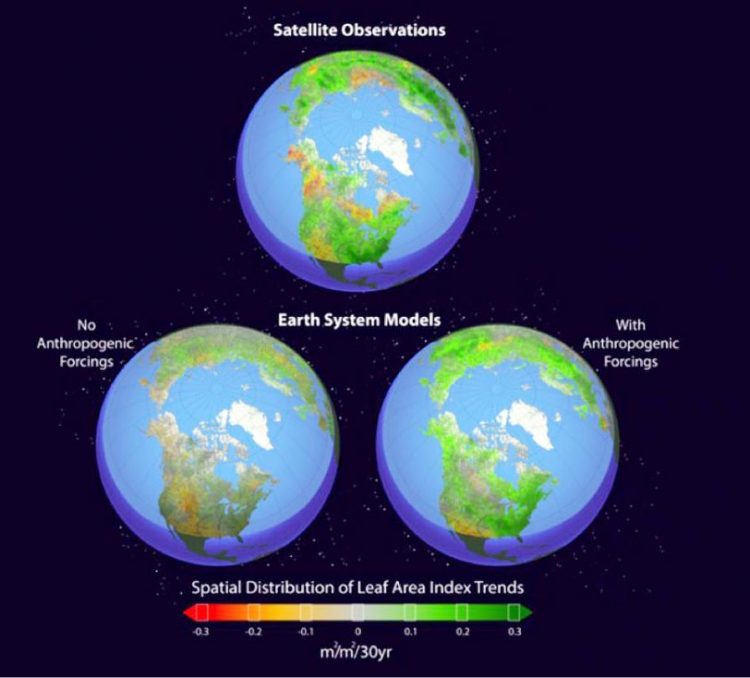Climate study finds human fingerprint in Northern Hemisphere greening

Earth system models simulate Northern Hemisphere greening. Figure shows the spatial distribution of leaf area index trends (m2/m2/30yr) in the growing season (April-October) during the period of 1982-2011 in the mean of satellite observations (top), Earth system model (ESM) simulations with natural forcings alone (lower left) and ESM simulations with combined anthropogenic and natural forcings (lower right). Credit: ORNL
The research team, led by Jiafu Mao of the Ecosystem Simulation Science group in the Environmental Sciences Division, used new environmental data and strict statistical methods to discover a significant human-vegetation interaction in the northern extratropical latitudes, the section of the planet spanning 30 to 75 degrees north, roughly between the Tropic of Cancer and the North Frigid Zone above the Arctic Circle.
“This is the first clear evidence of a discernible human fingerprint on physiological vegetation changes at the continental scale,” Mao said.
With the absence of long-term observational records and suitable Earth system model (ESM) simulations, the human “touch” on northern latitude greening had not been previously identified. The team used two recently available 30-year-long leaf area index data sets, 19 ESM simulations and a formal “detection and attribution” statistical algorithm to positively attribute changes in vegetation activity in the extratropical Northern Hemisphere to anthropogenic forcings, or human-induced climate inputs such as well-mixed greenhouse gas emissions.
Leaf area index — the ratio of leaf surface area to ground area — is an indicator of vegetation growth and productivity derived from satellite imaging. The remote-sensing-based LAI datasets and ESM simulations showed a significant “greening” trend over the northern extratropical latitudes vegetated area between 1982 and 2011, indicating increased vegetative productivity.
When Mao and his colleagues accounted for internal climate variability and responses to natural forcings such as volcanic eruptions and incoming solar radiation, it was clear that the greening was inconsistent with simulations of purely natural factors and could only be explained by anthropogenic greenhouse gas forcings, particularly elevated carbon dioxide concentrations.
This anthropogenic greening effect has the potential to alter natural processes on a planetary scale. Continent-wide changes in vegetative productivity, such as those in the study, impact energy exchanges, water use and carbon budgets, accelerating or slowing the pace of climate change.
Accurate detection and attribution of changes in vegetation growth patterns are essential for strategic decision-making in ecosystem management, agricultural applications and sustainable development and conservation. This is the first time the detection and attribution algorithm has been applied to terrestrial ecosystem changes such as leaf area index trends, as it is typically used to study physical climate data such as extreme events and variations in temperature or precipitation.
Mao would like to see these long-term regional- and global-scale observational data sets used in similar studies as they become available. He says the detection and attribution algorithm could be applied to study broad-scale terrestrial ecosystem dynamics, and the framework developed for this study could be used to identify and correct potential errors in next-generation ESM simulations.
###
The study and its results are reported in the article “Human-induced greening of the northern extratropical land surface” in Nature Climate Change. Other ORNL participants and coauthors were Xiaoying Shi, Peter Thornton, Dan Ricciuto and Forrest Hoffman.
This study was supported by the DOE Office of Science.
ORNL is managed by UT-Battelle for the Department of Energy's Office of Science, the single largest supporter of basic research in the physical sciences in the United States. DOE's Office of Science is working to address some of the most pressing challenges of our time. For more information, please visit science.energy.gov.
Image: https:/
Caption: Earth system models simulate Northern Hemisphere greening. Figure shows the spatial distribution of leaf area index trends (m2/m2/30yr) in the growing season (April-October) during the period of 1982-2011 in the mean of satellite observations (top), Earth system model (ESM) simulations with natural forcings alone (lower left) and ESM simulations with combined anthropogenic and natural forcings (lower right).
NOTE TO EDITORS: You may read other press releases from Oak Ridge National Laboratory or learn more about the lab at http://www.
Twitter – http://twitter.
RSS Feeds – http://www.
Flickr – http://www.
YouTube – http://www.
LinkedIn – http://www.
Facebook – http://www.
Media Contact
All latest news from the category: Earth Sciences
Earth Sciences (also referred to as Geosciences), which deals with basic issues surrounding our planet, plays a vital role in the area of energy and raw materials supply.
Earth Sciences comprises subjects such as geology, geography, geological informatics, paleontology, mineralogy, petrography, crystallography, geophysics, geodesy, glaciology, cartography, photogrammetry, meteorology and seismology, early-warning systems, earthquake research and polar research.
Newest articles

First-of-its-kind study uses remote sensing to monitor plastic debris in rivers and lakes
Remote sensing creates a cost-effective solution to monitoring plastic pollution. A first-of-its-kind study from researchers at the University of Minnesota Twin Cities shows how remote sensing can help monitor and…

Laser-based artificial neuron mimics nerve cell functions at lightning speed
With a processing speed a billion times faster than nature, chip-based laser neuron could help advance AI tasks such as pattern recognition and sequence prediction. Researchers have developed a laser-based…

Optimising the processing of plastic waste
Just one look in the yellow bin reveals a colourful jumble of different types of plastic. However, the purer and more uniform plastic waste is, the easier it is to…



